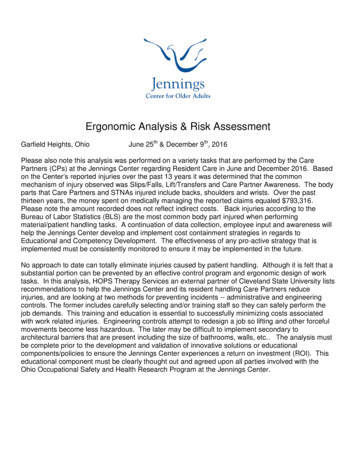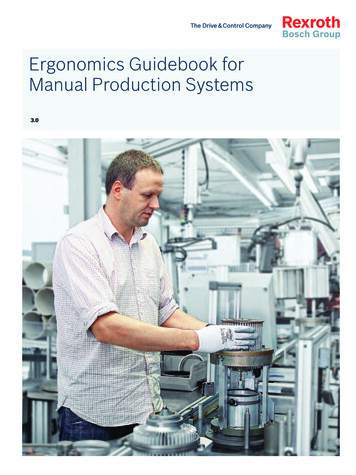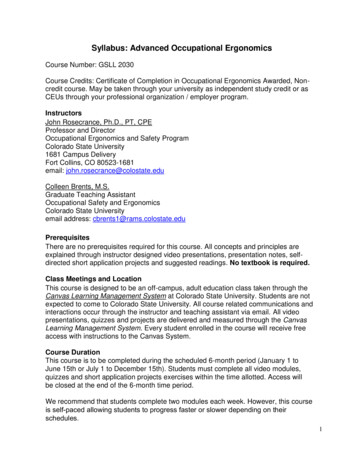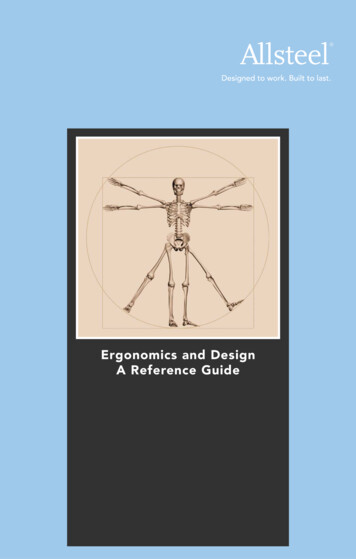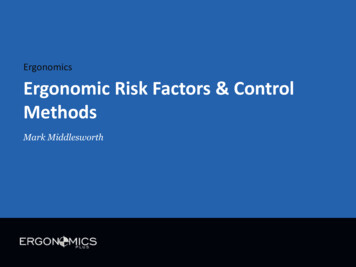
Transcription
ErgonomicsErgonomic Risk Factors & ControlMethodsMark Middlesworth
MSD Risk FactorsERGONOMICRISK FACTORS- FORCE- REPETITION- POSTUREOver time, exposure to risk factors leads to MSD.INDIVIDUALRISK FACTORS- POOR WORK PRACTICES- POOR HEALTH PROFILE- NO RECOGNITION OF EARLY. WARNING SIGNSMSD
MSD Prevention ControlsERGONOMICCONTROLSIdentify and removeergonomic risk factors.Prevent MSDs by identifying and removing risk factors.INDIVIDUALCONTROLSIdentify and removeindividual risk factorsPREVENTMSDs
Primary Ergonomic Risk FactorsThere are three primary ergonomic risk factors:1. HIGH TASK REPETITION2. FORCEFUL EXERTIONS3. REPETITIVE / SUSTAINED AWKWARD POSTURES
Primary Ergonomic Risk FactorsREPETITIONFORCEPOSTURERISK FACTOR: HIGH TASK REPETITIONMany work tasks and cycles are repetitive in nature, and arefrequently controlled by hourly or daily production targetsand work processes.High task repetition, when combined with other risks factorssuch high force and/or awkward postures, can contribute tothe formation of MSD. A job is considered highly repetitive ifthe cycle time is 30 seconds or less.
Primary Ergonomic Risk FactorsREPETITIONFORCEPOSTURECONTROL METHODS FOR HIGH TASK REPETITIONEngineering ControlsEliminating excessive force and awkward posturerequirements will reduce worker fatigue and allow highrepetition tasks to be performed without a significantincrease in MSD risk for most workers.
Primary Ergonomic Risk FactorsREPETITIONFORCEPOSTURECONTROL METHODS FOR HIGH TASK REPETITIONWork Practice ControlsProviding safe & effective procedures for completing worktasks can reduce MSD risk. In addition, workers should betrained on proper work technique and encouraged to accepttheir responsibilities for MSD prevention.
Primary Ergonomic Risk FactorsREPETITIONFORCEPOSTURECONTROL METHODS FOR HIGH TASK REPETITIONJob RotationJob task enlargement is a way to reduce duration, frequencyand severity of MSD risk factors. Workers can rotate betweenworkstations and tasks to avoid prolonged periods ofperforming a single task, thereby reducing fatigue that canlead to MSD.
Primary Ergonomic Risk FactorsREPETITIONFORCEPOSTURECONTROL METHODS FOR HIGH TASK REPETITIONCounteractive Stretch BreaksImplement rest or stretch breaks to provide an opportunityfor increased circulation needed for recovery.
Primary Ergonomic Risk FactorsREPETITIONFORCEPOSTURERISK FACTOR: EXCESSIVE FORCEMany work tasks require high force loads on thehuman body.Muscle effort increases in response to high forcerequirements, increasing associated fatigue whichcan lead to MSD.
Primary Ergonomic Risk FactorsREPETITIONFORCEPOSTURECONTROL METHODS FOR EXCESSIVE FORCEEngineering ControlsEliminating excessive force requirements will reduce workerfatigue and the risk of MSD formation in most workers. Usingmechanical assists, counter balance systems, adjustableheight lift tables and workstations, powered equipment andergonomic tools will reduce work effort and muscleexertions.
Primary Ergonomic Risk FactorsREPETITIONFORCEPOSTURECONTROL METHODS FOR EXCESSIVE FORCEWork Practice ControlsWork process improvements such as using carts and dollies toreduce lifting and carrying demands, sliding objects insteadof carrying or lifting, and eliminating any reachingobstruction to reduce the lever arm required to lift theobject.
Primary Ergonomic Risk FactorsREPETITIONFORCEPOSTURECONTROL METHODS FOR EXCESSIVE FORCEProper Body MechanicsWorkers should be trained to use proper lifting and worktechniques to reduce force requirements.
Primary Ergonomic Risk FactorsREPETITIONFORCEPOSTURERISK FACTOR: SUSTAINED AWKWARD POSTURESAwkward postures place excessive force on joints andoverload the muscles and tendons around the effected joint.Joints of the body are most efficient when they operateclosest to the mid-range motion of the joint.Risk of MSD is increased when joints are worked outside ofthis mid-range repetitively or for sustained periods of timewithout adequate recovery time.
Primary Ergonomic Risk FactorsREPETITIONFORCEPOSTURECONTROL METHODS FOR SUSTAINED, AWKWARD POSTURESEngineering ControlsEliminate or reduce awkward postures with ergonomicmodifications that seek to maintain joint range of motion toaccomplish work tasks within the mid-range of motionpositions for vulnerable joints. Proper ergonomic tools shouldbe utilized that allow workers to maintain optimal jointpositions.
Primary Ergonomic Risk FactorsREPETITIONFORCEPOSTURECONTROL METHODS FOR SUSTAINED, AWKWARD POSTURESWork Practice ControlsWork procedures that consider and reduce awkward posturesshould be implemented. In addition, workers should betrained on proper work technique and encouraged to accepttheir responsibility to use their body properly and to avoidawkward postures whenever possible.
Primary Ergonomic Risk FactorsREPETITIONFORCEPOSTURECONTROL METHODS FOR SUSTAINED, AWKWARD POSTURESJob RotationJob rotation and job task enlargement is a way to reducerepeated and sustained awkward postures that can lead toMSD.
Primary Ergonomic Risk FactorsREPETITIONFORCEPOSTURECONTROL METHODS FOR SUSTAINED, AWKWARD POSTURESCounteractive Stretch BreaksImplement rest or stretch breaks to provide an opportunityto counteract any repeated or sustained awkward posturesand allow for adequate recovery time.
Learn more aboutergonomic risk factors.Click the link below:http://ergo-plus.com/ergonomic-risk-factors/
Get more ergonomics and injuryprevention tips at Ergo-Plus.com.Click the link below:www.ergo-plus.com
Primary Ergonomic Risk Factors REPETITION FORCE POSTURE Many work tasks and cycles are repetitive in nature, and are frequently controlled by hourly or daily production targets and work processes.


